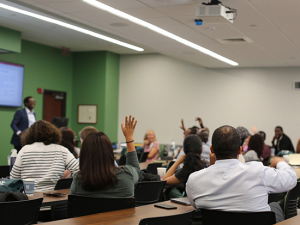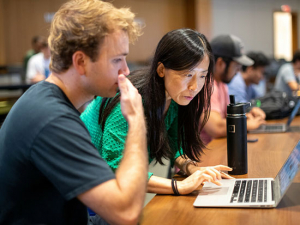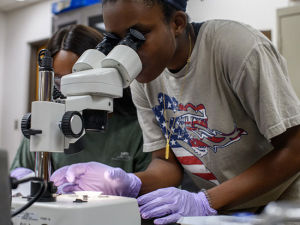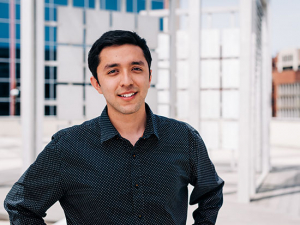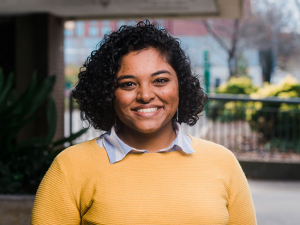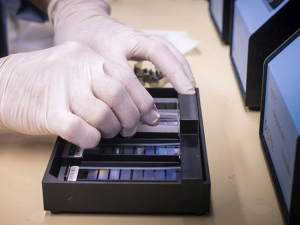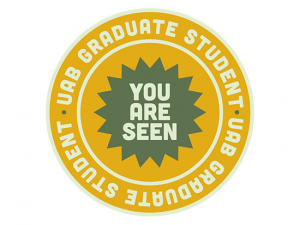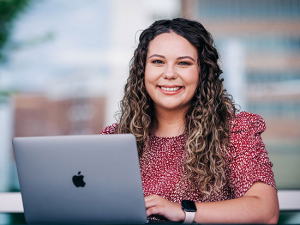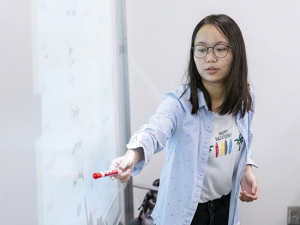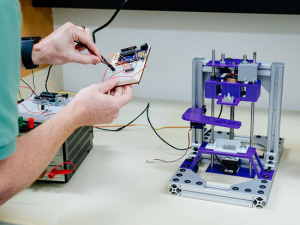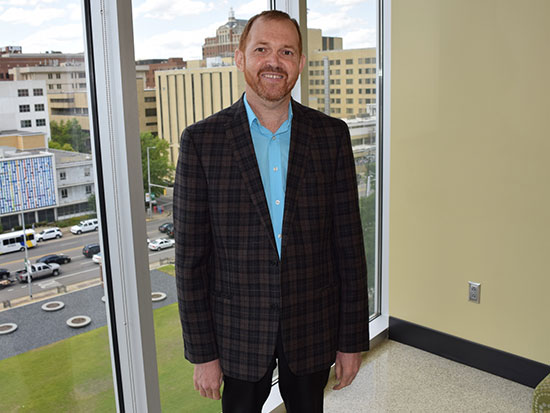 Associate Professor Muhammad Maqbool, Ph.D., is a prolific researcher who regularly involves students in his projects. "If a student has published a paper, that student is an expert in that field in the eyes of employers," Maqbool said. "Whenever I get a call from a prospective employer about a student for which I've written a reference, they ask about the research. They are very interested."Radiation is everywhere in health care settings, from the X-ray machine at your dentist's office to the MRI and CT devices in many hospitals to the cutting-edge PET scanners in UAB's Advanced Imaging Facility and Proton Therapy Center.
Associate Professor Muhammad Maqbool, Ph.D., is a prolific researcher who regularly involves students in his projects. "If a student has published a paper, that student is an expert in that field in the eyes of employers," Maqbool said. "Whenever I get a call from a prospective employer about a student for which I've written a reference, they ask about the research. They are very interested."Radiation is everywhere in health care settings, from the X-ray machine at your dentist's office to the MRI and CT devices in many hospitals to the cutting-edge PET scanners in UAB's Advanced Imaging Facility and Proton Therapy Center.
"These devices are all very beneficial to patients, but there is always the possibility of damaging effects of radiation as well," said Muhammad Maqbool, Ph.D., associate professor in the Department of Clinical & Diagnostic Sciences and the only full-time member of the department's master's degree program in Health Physics. The program, launched in 2017, is the only one of its kind in Alabama and one of a small number nationwide. "Our program's main purpose is to produce graduates who can set up rules and regulations to shield people from those damaging effects of radiation," Maqbool said. "At the same time in our program we also look at the positive side, at the benefits of radiation and how we can better exploit those benefits.”
‘Not enough people’
After she graduated from Ball State University with an undergraduate physics degree, “I knew that I wanted to become more specialized,” said Kayla Stinson, who graduated from UAB’s health physics program in 2019 and now works on the Radiation Safety Team in Emory University’s Environmental Health and Safety Office. “As soon as I started learning about the field of health physics, I realized not only its importance, but the lack of people available to do the work. There are not enough people with the ideal education and experience compared to the amount of work to be done.”
| "Our program's main purpose is to produce graduates who can set up rules and regulations to shield people from those damaging effects of radiation. At the same time in our program we also look at the positive side, at the benefits of radiation and how we can better exploit those benefits.” |
The program's graduates work in hospitals and universities, as well as in industry, in the military and in academia, Maqbool said. Guy Yembi-Goma works as a medical physics assistant at UAB’s Proton Therapy Center, one of several graduates now working at UAB, Maqbool said. Yembi-Goma also is a published research author, with an article on Comparison of Methods and Systems in Internal Radiation Dosimetry in the Biomedical Journal of Scientific and Technical Research and another article in press. “I chose UAB because of the outstanding faculty and quality of education,” he said. “UAB is a great institution with a proven record.”
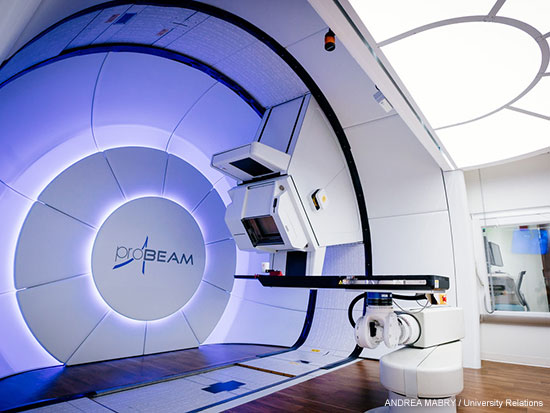 Health Physics program graduate Guy Yembi-Goma now works at UAB's Proton Therapy Center (shown above). “I chose UAB because of the outstanding faculty and quality of education,” he said. “UAB is a great institution with a proven record.”
Health Physics program graduate Guy Yembi-Goma now works at UAB's Proton Therapy Center (shown above). “I chose UAB because of the outstanding faculty and quality of education,” he said. “UAB is a great institution with a proven record.”
Research possibilities
“While at UAB, students have the chance to contribute to original research in the field,” Maqbool said. His research focus is on the development of new materials for radiation shielding and protection, along with materials for other biomedical applications. He has established collaborations with investigators across the globe, including Stanford University, the Korean Advanced Institute of Science & Technology and the University of Erlangen in Germany. Maqbool also is the editor of the journal Nanoscale Research Letters.
His students benefit from this exposure to cutting-edge research. "I assign projects to students in radiation shielding and protection, which have the potential to provide better treatments to patients as well as protection to patients and providers, including nurses, technicians and physicians," Maqbool said. He and his students study the properties of body tissues and how they are specifically affected by radiation; they also investigate new types of shielding and protection. Support for these activities comes from Health Physics program director Norman Bolus and Remo George, Ph.D., who is engaged in research activities in the Nuclear Medicine Technology program, Maqbool says.
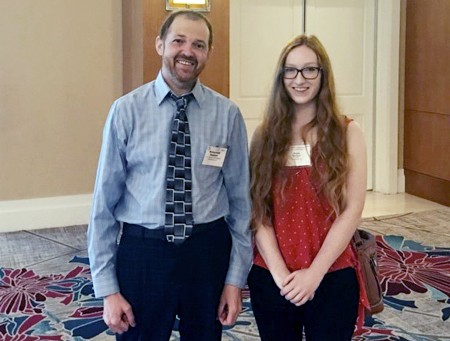 Maqbool and student Kayla Stinson at the Health Physics Society annual meeting in 2019, where Stinson was awarded a prize for her research presentation.Why are new shielding materials necessary? "Lead is a very heavy and effective shielding material, but it is also toxic," Maqbool explained. "If lead dust accumulates and is swallowed it can be very damaging. Some of my students have investigated the radiation scattering and absorption characteristics of alternative materials that work as well as lead but are not toxic."
Maqbool and student Kayla Stinson at the Health Physics Society annual meeting in 2019, where Stinson was awarded a prize for her research presentation.Why are new shielding materials necessary? "Lead is a very heavy and effective shielding material, but it is also toxic," Maqbool explained. "If lead dust accumulates and is swallowed it can be very damaging. Some of my students have investigated the radiation scattering and absorption characteristics of alternative materials that work as well as lead but are not toxic."
In 2019, Stinson received a prize for her research presentation at the annual meeting of the Health Physics Society. Her presentation, based on her talk "Characterization of MCP-124 and MCP-150 Alloys for Beam Collimation and Radiation Shielding," was one of only two winners out of more than 320 oral and poster presentations. "That was a big recognition for Kayla and for our program, competing against so many researchers from around the world," Maqbool said. Stinson also worked with George and another graduate student on a study of the use of cerium oxide nanoparticles to make breast cancer cells more sensitive to radiation therapy, which was published in the journal Biochemistry and Biophysics Reports.
Elijah Halliwell, who graduated in December 2020, worked on radiation shielding studies with Maqbool. The fact that UAB’s health physics program is one of the accreditation-seeking master’s programs in the country was a major draw, says Halliwell, who like Stinson was a physics major at Ball State University. “And the overall emphasis on research study made it really appealing to me, coming from a heavy research field,” he said. Halliwell had offer letters from several health departments and companies after he graduated. He now is a medical physics assistant at Landauer Medical, a major radiation safety and services company. In the future, he plans to pursue his doctorate in nuclear physics. “Knowing how to handle yourself with the use of radiation and radioactive material is an indispensable skill,” he said.
Productive in the pandemic
| “There are a number of interesting, fulfilling and high-paying jobs available to the right candidate. I would encourage anyone with a strong STEM background to consider this field as an option.” |
The COVID-19 pandemic halted regular activities around the world, but 2020 was a highly productive year for Maqbool and student researchers in the health physics program. Between January 2020 and January 2021, Maqbool published 11 papers in high-impact journals in the field, including Characterization of 83Bi209, 74W184, 48Cd112, 30Zn65, 28Ni59 and 26Fe56 using Modified Klein-Nishina formula, for radiation shielding and dosimetry in Radiation Physics & Chemistry and Highly Sensitive Voltage Switchable Dual Analyte Biosensor Using Au NPs Sputtered CdS QDs Decorated TiO2 Nanotubes: A Study of Nonenzymatic Detection of Cholesterol and H2O2 in Applied Materials and Interfaces.
He also mentored nine graduate students in their research projects during that time, and four of them already have published papers, with more in the pipeline, Maqbool said.
Student publications help build prestige for UAB's Health Physics program, but they also are "invaluable in students' job searches, whether or not they plan on continuing in academia," Maqbool said. "If a student has published a paper, that student is an expert in that field in the eyes of employers. Whenever I get a call from a prospective employer about a student for which I've written a reference, they ask about the research. They are very interested."
“There are a number of interesting, fulfilling and high-paying jobs available to the right candidate,” Stinson said. “I would encourage anyone with a strong STEM background to consider this field as an option.”



